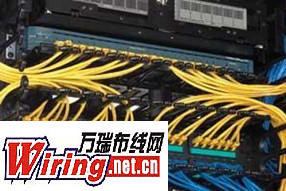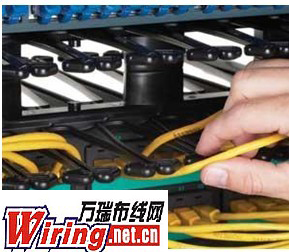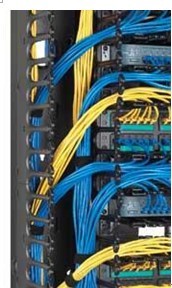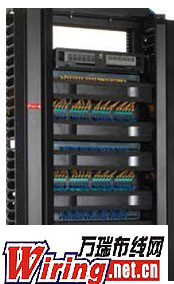|
As the information technology (IT) age moves well into the new millennium, the amount of data that companies handle is continuously increasing, making it challenging for IT departments to keep cable networks up-to-date, running smoothly, and sufficient for their companies' needs. Many businesses using Category 5e cables are finding their systems overloaded and experiencing major delays.

Escalating cable densities, if not handled properly, can hinder network performance. Effective cable organization requires a combination of durable construction and flexible design to minimize labor and expenses.
Since the advent of higher-capacity cables designed to better handle increased data transmission, Category 5e is no longer the most commonly requested for new cabling installations. Yet many of the 19-inch racks currently found in telecommunications rooms are designed with Category 5e in mind, making it challenging to integrate the latest, larger-diameter and higher-capacity cables.
Now is the time for IT professionals to rethink cable management—taking present and future cabling into consideration. Analyzing why cabling standards are evolving and how storage area networks (SANs) have changed data communications is the first step, followed by looking at existing and emerging cable-management solutions to determine the one best designed to meet your business's needs.
Keeping pace with change
The 568 series of cabling standards from the Telecommunications Industry Association/Electronics Industries Alliance (TIA/EIA) date back nearly 20 years and include the original 568 as well as the 568-A and 568-B standards—as well as the 568-C standard currently in development. The original TIA/EIA-568 brought the industry interoperability, standard cable minimum performance, standardized terminations, and standardized topologies. This development took the industry from using a series of proprietary cabling systems to universally open networks for simpler integration and increased usability.
Now, the technology behind these standards is quickly evolving. The emergence of 10- or even 100-Gbit/sec Ethernet has reshaped data transmission. With IT convergence—including voice, video, data, access control, and security requirements—the industry is now demanding faster operating speeds while processing more information. To accommodate these increasing data-transmission requirements, higher-capacity cables, such as Category 6 and 6A, were developed to deliver robust, efficient, data communications.
As cable-transmission performance has changed, so have other physical components that TIA/EIA does not always directly address, including size, construction, and termination means. Higher-performance cable size and installation requirements, along with increased equipment densities, have strained currentcable pathways and hindered cable management in open frame racks and cabinets.
Feeling the squeeze
As noted, high-capacity cables are larger in size to accommodate greater amounts ofdata, making them challenging to successfully install into existing cable-management systems. Many companies are trying to fit these new varieties into their existing racks, housed within increasingly dense network spaces. Until recently, a single network server had a sole application and ran for only the amount of time needed to perform that application—sometimes less than an hour a day. The introduction of SANs and server virtualization driven by high-density network switches, however, has altered this arrangement and now includes all servers in the handling of all networks.

Facilitating simple cable insertion and efficient moves, adds, and changes is a cable-management system's prime responsibility. Rounded fingers combined with sturdy end posts ensure cable installation and modifications are easily made and that cable bundles stay in place.
SANs and server virtualization improve network efficiency by allowing for shared servers, with a network switch controlling data traffic and communicating necessary information to each connected server and storage unit. The result is fewer servers and increased network performance—saving businesses significant time, space and cost.
As the number of individual servers is reduced,however, switches are becoming larger and heavier, with a greater number of ports and much higher cable densities than previous-generation technologies. Plus, while fewer serversare required, their more-compact design has increased the number of units installed per rack. Additional electronic equipment has followed suit, with routers, hubs, and network appli-ances all consuming a smaller footprint by being installedcloser together.

As cables increase in size, cable-management system capacities must follow suit. Deep fingers deliver increased cable fill for the latest high-density network switches, servers, and other electronic equipment while providing the bend radius required for Category 5e and higher-capacity cables.
Fewer racks, more jacks
The result is fewer data racks but more terminations and jacks within that given area, considering cabling must be provided in front of, behind, and between all rack-mounted equipment.
Given these changes, cable installation has become a more sensitive procedure, as companies are striving to reduce installation costs while increasing the effectiveness of their cable networks. IT professionals are running wider, higher-capacity cables to a significantly larger number of ports within a more restricted space. This increased cable density makes installation more difficult and can hinder cable performance, sincethe space restriction can prohibit IT professionals frommaintaining the correct cable bend radius.
In addition, as departments continue to grow and equipment is updated, moves, adds and changes (MACs) occur more frequently. The crowded state of data racks has made even small alterations time-consuming and labor-intensive projects, costing businesses much of the resources otherwise saved bySANs and increasingly efficient technology.
To keep up with industry's frequent equipment and cabling changes, cable management can currently be configuredusing one of several arrangements. One is a cable pathway, which is available in several designs (such as ladder rack or basket) and allows cables to be run horizontally. Open frame racks (2- and 4-post styles) are also available, as are several types of floor-standing or wall-mount data communications cabinets that are designed to make the most efficient use oflimited network space.
While many of today's cable-management systems can accommodate high-capacity cables, the extra space consumed results in lower fill capacities, generating the need for add-itional cable managers and, therefore, additional space—already at a premium in most data closets. Furthermore, a new cable size dictates a new bend radius; if existing data racks do not support the correct bend radius, cables can be damaged and their performance compromised. With these data racks, the time and labor required to update a cable network can quickly add up to more than companies are willing to pay.

Optimizing cable management to accommodate today's rapidly evolving technology requires a versatile, multi-faceted solution catered to meet current and future capacity needs.
Cable-management systems must become far more sophisticated and versatile, and vertical and horizontal cable managers need several key changes to keep up with industry trends. For example, every new rack must be optimized to effectively replace multiple racks within a network area, meaning that capacity must be significantlyincreased. In addition, ascables increase in size and more electronic components are installed, a greater number ofcables will be needed. Racks must be durable enough to physically support these increases while maintaining the correct bend radius so networkperformance is not hindered.
Additionally, cable-management systems need deep "fingers" for optimal rack-space use and to deliver the bend radius required for Category 5e and higher-capacity cables. These supportive fingers provide larger tie-down areas andsturdy end posts to keep heavy cable bundles in place and prevent cable damage while optimizing performance. Plus, a system with rounded fingeredges will further minimize cable twisting, nicking, andover-stretching during installation.
Because electronic components can be installed in many ways and wired from numerous directions, the ideal solution is a cable management system that features bi-direc-tional hinging and can transition between horizontal andvertical arrangements. Also, to optimize time and spacedespite the increasing amount of cabling, the cable management system should be lightweight and flexible to facilitate quick cable insertion and feature easily opened doors with positive engagement to expedite and simplify MACs.
Additional features, such as pass-through holes for increased wiring flexibility, a cable tie-down bar for rear bundle-support, and a simplified system-mounting configuration—with tool-less, snap-in installation—will further enhance cable network organization and reduce labor expenses.
Maximizing space, minimizing cost
To best reap the benefits provided by high-capacity cables and accommodate new technology and increased data transmission—all within tight IT department budgets and space constraints—cable management must be cost-effective, time-efficient, adaptable to support upcoming cable trends as well as existing networks, and comply with TIA/EIA standards. This can be accomplished by selecting a data rack and cable managers that establish the correct cable bend radius, have high fill-capacities and deep "fingers" to holdwider cables, and offer sufficient accessibility to cabling—even when the rack is fully populated
When paired with sturdy yet flexible construction, these data racks will allow IT departments to maximize space while minimizing labor and costs.
|